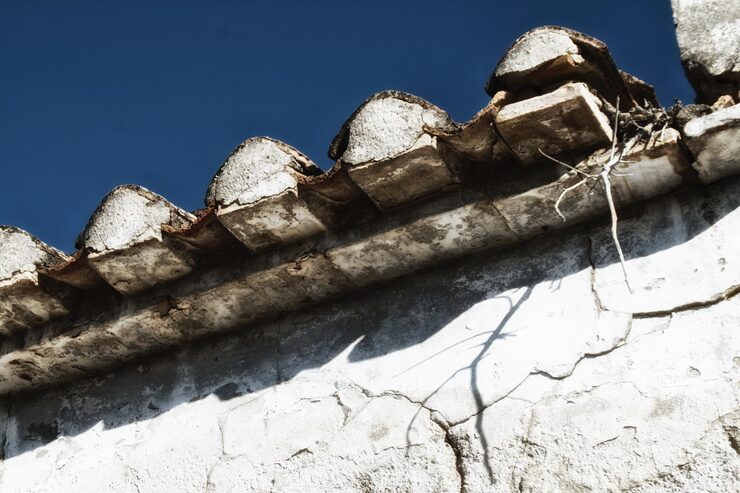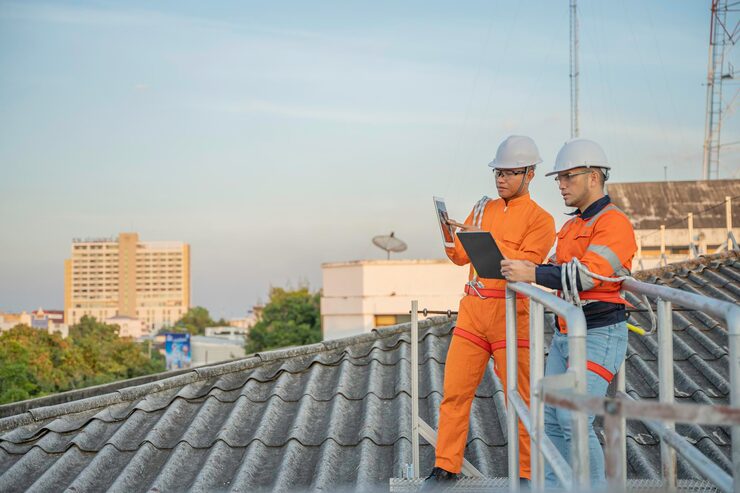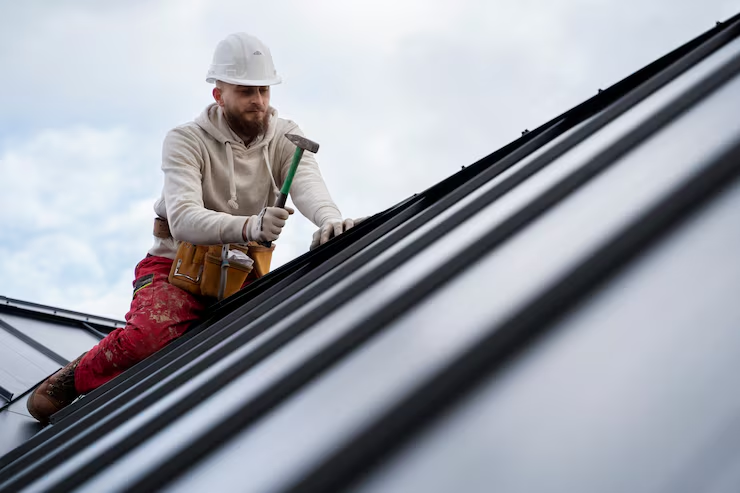
Table of Contents
Key Takeaways
✔ Sagging or uneven roof lines can signal serious structural weakness.
✔ Unusual creaking, popping, or groaning sounds often point to stressed roof components.
✔ Cracks in walls, ceilings, or masonry may indicate shifting load from above.
✔ Doors or windows that suddenly jam can be a sign of frame distortion from roof stress.
✔ Persistent leaks or water damage weaken roof materials and supports
✔ Heavy or uneven snow, ice, or debris loads can push a roof beyond its safe capacity
✔ Seasonal professional inspections help detect problems before they escalate.
✔ Acting quickly on warning signs can prevent costly damage and safety hazards.
Roof collapses rarely happen without warning, yet the early signs often go unnoticed until it’s too late. From shifting rooflines to strange structural noises, these red flags can point to serious underlying damage that threatens both safety and property. Understanding and acting on these indicators can mean the difference between a manageable repair and a catastrophic failure.
Here are six critical warning signs a roof may be on the verge of collapsing.

Which Is an Indication of Possible Roof Collapse? 6 Signs of Ceiling Collapse
1. Sagging or Uneven Roof Lines
A roof should form a straight, even line across its span. When dips, curves, or an irregular silhouette appear, it signals a shift in the structure’s ability to carry weight. This visible change is more than cosmetic—it can be the first visual clue of serious structural trouble, which is an indication of possible roof collapse.
- Visible Dips in the Roof Surface: A clear downward curve between rafters or along the ridge often means the load-bearing elements are weakening. Over time, water intrusion, wood rot, or termite damage can cause these areas to lose strength, allowing the roof to deform under normal weight.
- Warped or Misaligned Fascia Boards: The horizontal boards along the roof edge should be flush and level. When they appear slanted or twisted, it can indicate that underlying rafters have shifted, putting uneven pressure on the roof frame.
- Changes After Heavy Weather Events: After significant snow, ice, or storm conditions, a roof that was once straight may suddenly appear bowed. This is often the result of added stress on compromised structural members, pushing them past their safe load limit.
2. Unusual Creaking, Popping, or Groaning Noises
Structural components in a roof are designed to handle normal stress silently. When beams or trusses begin to emit creaks, pops, or groans, it signals they are straining beyond their comfort zone. These unexpected sounds can happen suddenly and may worsen under heavy load.
- Sounds During Weather Changes: Temperature shifts cause materials to expand and contract, but when the noise is loud or frequent, it may mean the structure is under dangerous strain. This is especially concerning if the sounds intensify during heavy rain, wind, or snow.
- Sharp Pops Under Heavy Load: A distinct popping sound often occurs when fasteners, nails, or bolts shift under excessive weight. This shifting weakens the joints and can quickly escalate to visible damage if left unchecked.
- Groaning From Support Beams: A deep groan from wood or metal beams can mean the weight load is pushing them to their limit. In older roofs, this often combines with internal weakening from rot or rust.
3. Cracks in Interior Walls, Ceiling, or Masonry
Cracks inside a building often reveal what’s happening above. When load distribution changes due to a weakening roof, stress travels down into the walls and ceilings. In many cases, these cracks are structural red flags, which is an indication of possible roof collapse.
- Widening or Spreading Cracks: A crack that grows over days or weeks suggests an active shift in the building’s frame. This movement can result from roof trusses bending or pulling away from their original positions.
- Cracks Near Ceiling and Wall Joints: These specific locations are vulnerable when the roof begins to sag. The added pressure causes visible separations where the walls meet the ceiling, showing that the structure is flexing under stress.
- Diagonal Cracks in Masonry: When brick or block walls show diagonal cracks, it’s often due to uneven weight distribution from above. This is a serious sign that should prompt immediate inspection before further damage spreads.
4. Doors or Windows Suddenly Jamming
When a roof shifts, it can subtly change the shape of the entire building frame. This often leads to doors that scrape the floor or windows that refuse to open smoothly. While it may seem like a minor inconvenience, the underlying cause can be structural.
- Misaligned Frames From Structural Shifts: The load from a failing roof can warp walls just enough to throw door and window frames out of square. This misalignment is often accompanied by cracks forming nearby.
- Changes After a Storm or Snowfall: If jamming begins shortly after a heavy weather event, it may be linked to increased load or moisture-related swelling in structural materials. This often points to hidden roof strain.
- Uneven Floors Accompanying Jams: In some cases, door or window issues come with a noticeable tilt or slope in the flooring. This indicates that the shifting weight has traveled down through the frame into the foundation.
5. Visible Water Damage or Persistent Leaks
Water is one of the fastest ways to weaken roof materials. Leaks that appear during rain or snowmelt can compromise the load-bearing capacity of beams and decking. Over time, the rot, mold, and rust caused by moisture can create a dangerous situation, which is an indication of possible roof collapse.
- Stains That Grow Over Time: Expanding water stains on ceilings or upper walls suggest ongoing leaks. As the water spreads, it erodes wood fibers, corrodes metal fasteners, and weakens structural joints.
- Mold and Mildew Development: Persistent moisture promotes fungal growth that eats away at wood. Beyond the health hazards, this biological damage can cause beams to lose their rigidity.
- Warped or Soft Roof Decking: When the roof surface feels spongy underfoot, the decking has likely absorbed too much water. This can cause sudden failure when exposed to even moderate weight.
6. Heavy or Uneven Snow, Ice, or Debris Load
A roof is designed to carry a certain amount of weight, but when that limit is exceeded, structural failure can happen quickly. Heavy, wet snow, thick ice layers, or piled-up debris can push a roof past its safe capacity. In these situations, the added strain can accelerate damage and increase the risk of collapse, which is an indication of possible roof collapse.
- Uneven Weight Distribution: Snow or debris collecting more on one side of the roof creates unbalanced pressure. This uneven load can cause one section to sag or buckle before the rest.
- Ice Dams Trapping Water: Ice dams along the roof edge prevent melting snow from draining. The trapped water seeps into materials and adds more weight as it refreezes.
- Neglected Debris Build-Up: Layers of wet leaves, branches, and dirt may seem harmless but can hold significant moisture. Over time, this extra weight combines with rot to weaken the structure from both above and within.
How to Perform a Basic Roof Inspection Without Climbing on It
With the global roofing materials market projected to reach USD 168.25 billion by 2030, it’s clear that maintaining and repairing roofs is not only a safety priority but also a growing investment worldwide. A roof inspection can reveal issues long before they become dangerous, but climbing on a roof poses safety risks and can cause further damage. By inspecting from the ground and using safe observation methods, it’s possible to spot problems early and call in a professional before they escalate.
1. Start With a Ground-Level Perimeter Walk
Walk slowly around the property, looking at the roof from different angles. Pay attention to sagging sections, uneven lines, or missing shingles that could indicate structural stress. Any change in shape or symmetry may connect to deeper issues that could lead to a collapsed roof if ignored.
2. Use Binoculars for a Closer Look
Binoculars allow for a detailed inspection of shingles, flashing, and joints without stepping onto the roof. Look for curling shingles, exposed nails, or rust around metal fixtures. Even small defects can be early signs your roof is going to collapse when combined with hidden internal damage.
3. Check for Uneven or Pooling Areas
Flat or low-slope roofs can collect water, which speeds up material decay. From the ground, look for dips that might hold standing water after rain. Persistent pooling can weaken the decking beneath, increasing the risk of sagging and eventual signs of ceiling collapse inside the property.
4. Look for Exterior Wall and Fascia Damage
Inspect the fascia boards and upper siding for warping, discoloration, or rot. These areas are directly connected to the roof’s edge and can reveal water penetration or structural stress. Damage here can be an indirect clue that the roof’s load-bearing capacity is failing, potentially leading to a collapsed roof.
5. Observe Gutters and Downspouts
Clogged or damaged gutters can cause water to back up under shingles. From the ground, check if gutters are pulling away from the house or overflowing during rain. This backup can lead to moisture damage in the decking, which often precedes signs your roof is going to collapse.
6. Monitor the Attic From Inside
Without stepping on the roof, the attic provides a safe place to detect trouble. Look for daylight peeking through, wet insulation, or sagging rafters. These warning signs often accompany visible roof problems outside and can be early indicators of ceiling collapse if left unaddressed.

How to Maintain Roof Health Through Seasonal Professional Checkups
In the U.S., roof replacement costs $9,521 on average—a hefty investment that makes preventive care a far more cost-effective choice. A well-maintained roof stands a much better chance of lasting through storms, heavy snow, and years of wear without unexpected failure. Seasonal professional checkups are essential because trained eyes can detect early warning signs that most property owners miss.
1. Schedule Inspections in Spring and Fall
The best times for professional checkups are after winter’s freeze and before summer’s heat, and again before winter storms arrive. These seasonal transitions are when structural weaknesses often reveal themselves. A professional inspection during these windows can identify small problems before they become signs roof is going to collapse.
2. Look Beyond Shingles to Structural Integrity
While missing or damaged shingles are important, a roofing professional examines trusses, decking, and load-bearing components. They have the tools and training to recognize subtle shifts or warping that signal deeper issues. Without this expertise, it’s easy to overlook the early stages of damage that could lead to a collapsed roof.
3. Check for Interior Indicators
A thorough seasonal check includes inspecting the attic and top-floor ceilings for leaks, stains, or sagging spots. Professionals know how to differentiate between harmless cosmetic marks and dangerous signs of ceiling collapse. Addressing these issues early can prevent them from spreading into full structural failure.
4. Monitor Drainage and Ventilation Systems
Proper drainage and ventilation reduce moisture buildup, which weakens materials over time. During a professional visit, gutters, downspouts, and roof vents are checked to ensure they are working properly. If neglected, blocked drainage can lead to pooling water—one of the overlooked contributors to signs your roof is going to collapse.
5. Inspect After Severe Weather Events
Seasonal inspections are important, but additional checkups after major storms are critical. Professionals can assess wind, hail, or snow load damage that might not be visible from the ground. These extra evaluations reduce the risk of progressive damage turning into a collapsed roof.
6. Keep Detailed Maintenance Records
A good roofing contractor will document each inspection, noting conditions, repairs, and potential trouble spots. These records help track patterns over time and guide preventive maintenance. This documented history becomes vital when determining the cause of sudden issues like signs of ceiling collapse or other structural concerns.

Frequently Asked Questions
What does a ceiling look like before it collapses?
Before a ceiling fails, there are often visible warning signs such as sagging, bowing, or uneven areas in the surface. Water stains, cracks spreading across the plaster or drywall, and bubbling paint are common signs of ceiling collapse in progress. In some cases, the ceiling may also feel soft to the touch or show bulging where water or debris has accumulated above. These visual cues should never be ignored, as they can be early signs your roof is going to collapse.
Can a ceiling collapse without warning?
While most failures give some form of advance warning, a ceiling can collapse suddenly if the damage is hidden or worsens quickly. Severe water intrusion, structural defects, or an overloaded roof can lead to a collapsed roof that causes the ceiling to give way with little notice. Sometimes the only clue is an unusual noise or a sudden shift in the structure. This is why regular inspections are critical to catch potential signs of ceiling collapse before they become dangerous.
How long before a ceiling collapses?
The time from the first signs of ceiling collapse to total failure can range from days to months, depending on the cause and severity. Small leaks or minor sagging may develop slowly, giving time for repairs if detected early. However, heavy water intrusion or structural overload from snow or debris can accelerate the process dramatically. Without prompt attention, these conditions can quickly escalate to a collapsed roof and severe safety hazards.
Is it unsafe to stay in a house after a ceiling collapses?
Yes, remaining in a house after a ceiling collapse is unsafe because the damage may extend to other parts of the structure. A collapsed roof or ceiling often means there are hidden weaknesses that could cause further failures. There may also be electrical hazards, falling debris, or compromised insulation. Evacuating and having a professional assess the damage is the safest course of action.
Is a collapsed ceiling an emergency?
A collapsed ceiling is absolutely an emergency because it signals serious structural failure. The incident may indicate signs your roof is going to collapse or that other areas are at immediate risk. Staying in the affected area can expose occupants to falling debris, unstable framing, or electrical hazards. Immediate evacuation and professional evaluation are necessary to secure the property and prevent further injury or damage.
Protect Poughkeepsie Homes with Lyndsey Roofing, LLC
At Lyndsey Roofing, LLC, we take pride in keeping homes in Poughkeepsie, NY, safe, dry, and strong through every season. Our team combines skilled craftsmanship with quality materials to handle everything from leak repairs to full roof replacements, ensuring long-lasting protection and curb appeal. We know the challenges local roofs face—from heavy winter snow to summer storms—and we address them with precision and care.
When it’s time to safeguard a home with dependable roofing services, trust the crew that treats every project like it’s their own. Contact us for expert roofing solutions!







